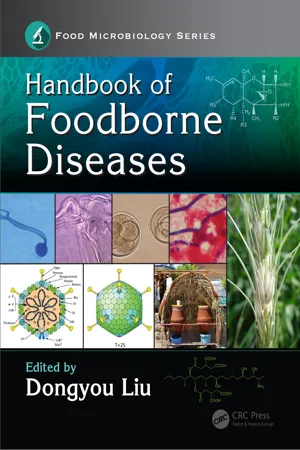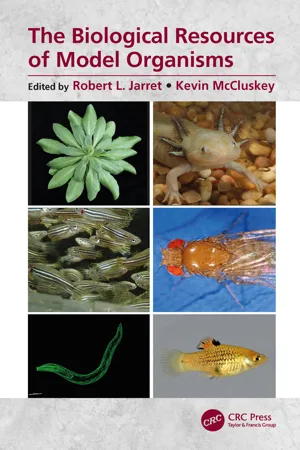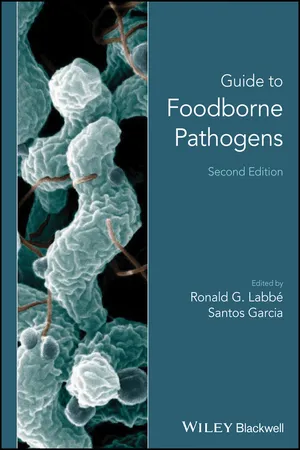Bacillus spp
"Bacillus spp" refers to a group of rod-shaped, Gram-positive bacteria commonly found in soil and water. They are known for their ability to form endospores, which allows them to survive harsh environmental conditions. Some species within this group are used in industrial and agricultural applications, while others can cause food spoilage and disease in humans and animals.
7 Key excerpts on "Bacillus spp"
- eBook - ePub
- Luis M. de la Maza, Marie T. Pezzlo, Cassiana E. Bittencourt, Ellena M. Peterson(Authors)
- 2020(Publication Date)
- ASM Press(Publisher)
...7 Bacillus The genus Bacillus belongs to the family Bacillaceae. There are more than 300 species of Bacillus ; however, the most frequently isolated are Bacillus cereus, Bacillus licheniformis, Bacillus megaterium, Bacillus mycoides, Bacillus pumilus, Bacillus simplex, Bacillus subtilis, and Bacillus thuringiensis. Another species, previously classified within the genus Bacillus, has been transferred to the genus Geobacillus. Geobacillus stearothermophilus is frequently used as an indicator organism in autoclave sterility testing. Most Bacillus spp. are saprophytes and are widely distributed in nature, but some are opportunists. The exceptions are Bacillus anthracis and B. cereus biovar anthracis, which are obligate pathogens of humans and animals. Microscopically, Bacillus spp. are Gram‐positive bacilli; however, it is not unusual for them to be Gram variable or Gram negative, especially in older cultures. They produce endospores and may be either aerobes or facultative anaerobes. Endospores are very resistant to heat, radiation, disinfectants, and desiccation and are frequent contaminants of otherwise clean environments, such as operating rooms, pharmaceutical products, and food. They can germinate when hydrated and, in the case of food, can cause spoilage or result in food poisoning. Bacillus spp. are catalase positive and hydrolyze gelatin, casein, and starch; most species, with the exception of B. anthracis and B. mycoides, are motile. Other tests that assist in the identification of Bacillus spp. are those for lecithinase production (egg yolk reaction), nitrate reduction, and the ability to grow anaerobically. Identification systems, e.g., API 20E (bioMérieux, Inc., Durham, NC), can be used to identify members of the B. cereus group. The pathogenicity of the B. cereus group is due to the production of cytolysins, endotoxins, exotoxins, and hemolysins. B...
- eBook - ePub
- Dongyou Liu, Dongyou Liu(Authors)
- 2018(Publication Date)
- CRC Press(Publisher)
...Part A: Gram-Positive Bacteria 15 Bacillus Dongyou Liu Contents 15.1 Introduction 15.2 Classification, Morphology, Structure, and Genome 15.3 Biology 15.4 Epidemiology 15.5 Clinical Features 15.6 Pathogenesis 15.7 Diagnosis 15.8 Treatment 15.9 Prevention 15.10 Conclusion References 15.1 Introduction The genus Bacillus covers a very large group of gram-positive, rod-shaped bacteria capable of producing oval endospores under stressful environmental conditions, which are spore-like, dormant, tough, nonreproductive structures, with strong resistance to heat, cold, radiation, desiccation, and disinfectants. Being ubiquitous in soil and other environments, Bacillus species are largely free-living (nonparasitic) saprophytes that play a role in the maintenance of ecological systems. However, some Bacillus species are known to be pathogenic (parasitic) to humans and animals, the most important of which are B. anthracis (the agent of anthrax) and B. cereus (involved in food poisoning). Depending on the route of infection, B. anthracis may cause (1) cutaneous anthrax (or hide porter’s disease), with B. anthracis spores entering through cuts on the skin and manifesting as a boil-like skin lesion that eventually develops into a large, painless necrotic ulcer with a black center (eschar); (2) gastrointestinal anthrax due to consumption of anthrax-infected meat, and presenting with vomiting of blood, severe diarrhea, acute inflammation of the intestinal tract, and loss of appetite; and (3) pulmonary anthrax resulting from inhalation of B. anthracis spores, with initial infection in the lymph nodes in the chest (hemorrhagic mediastinitis), causing bloody fluid to accumulate in the chest cavity with fever, shortness of breath, cough, fatigue, and chills as main symptoms, and subsequent spread to the lungs, inducing symptoms of pneumonia (e.g., high fever, extreme shortness of breath, shock, and rapid death) [ 1 ]. B...
- Grace R. Carter, John R. Cole Jr.(Authors)
- 2012(Publication Date)
- Academic Press(Publisher)
...18 Bacillus G.R. Carter Publisher Summary Members of the genus Bacillus are large, aerobic, gram-positive, and sporeforming rods. They are catalase positive; many are fermentative and most are motile. Bacillus species occur widely in nature, being found in the air, water, and soil. They are among the most common laboratory contaminants and are usually ignored when recovered from clinical materials. More than 40 species of Bacillus have been identified. This chapter discusses the more common and important species of Bacillus. They are Bacillus anthracis, Bacillus cereus, and Bacillus licheniformis. Anthrax is most frequently seen in cattle, in which it usually causes an acute septicemic infection. The numbers affected depend upon the source of Bacillus anthracis. The chapter reviews the pathogenicity, laboratory diagnosis, isolation procedures, and methods of identification of Bacillus anthracis. Bacillus cereus is a widespread saprophyte that is capable of infecting the bovine udder and producing acute and sometimes fatal gangrenous mastitis. It is a cause of abortion in cows and ewes.. The Bacillus species that have been implicated in human infections are Bacillus cereus, Bacillus circulans, Bacillus coagulans, Bacillus brevis, Bacillus pumulus, Bacillus macerans, Bacillus subtilis, Bacillus sphaericus, and Bacillus thuringiensis. Members of this genus are large, aerobic, gram-positive (old cultures decolorize easily), sporeforming rods. They are catalase positive; many are fermentative, and most are motile. Bacillus spp. occur widely in nature, being found in the air, water, and soil. They are among the most common laboratory contaminants and are usually ignored when recovered from clinical materials. One should, however, keep in mind the possibility of encountering B. anthracis, particularly in areas where the disease has occurred in the past. More than 40 species of Bacillus have been identified...
- eBook - ePub
The Biological Resources of Model Organisms
Collection, Characterization and Applications
- Robert L. Jarret, Kevin McCluskey, Robert L. Jarret, Kevin McCluskey(Authors)
- 2019(Publication Date)
- CRC Press(Publisher)
...One specialized type, the endospore, is a metabolically inert resting cell that is highly resistant to most environmental insults. When conditions are once again favorable for growth, spores germinate and grow out to establish new populations. This developmental suite has been termed the Bacillus Lifestyle (Zeigler and Nicholson 2017) and is not only a highly successful adaptation but also has practical consequences, many of them potentially beneficial, for human beings. Modern sequence-based taxonomic methods have revealed that Bacillus sensu lato comprises at least three bacterial families and dozens of genera. One species (Bacillus subtilis) and one particular laboratory strain (B. subtilis 168) have emerged as an important model organism. Thousands of useful genetic mutants and strain libraries have been developed over the past 70 years of B. subtilis research, especially during the 20 years since the genome sequence of strain 168 was determined. The Bacillus Genetic Stock Center (BGSC) exists as a steward of this legacy. It collects, maintains, distributes, and assembles data regarding these mutants and genetic tools, so that they will remain available in perpetuity for members of the research community. THE GENUS BACILLUS AND THE BACILLUS LIFESTYLE “The genus Bacillus,” wrote Ruth Gordon and colleagues in their authoritative handbook, “encompasses the rod-shaped bacteria capable of aerobically forming refractile endospores that are more resistant than vegetative cells to heat, drying, and other destructive agencies” (Gordon et al. 1973). More than four decades later, despite the revolution ushered in by recent technological and theoretical advances in biology, the definition remains essentially the same: Bacillus bacteria have cells that are “rod‐shaped, straight or slightly curved, occurring singly and in pairs, some in chains, and occasionally as long filaments...
- eBook - ePub
Handbook of Microbiology
Condensed Edition
- Allen I Laskin(Author)
- 2019(Publication Date)
- CRC Press(Publisher)
...The Genus Bacillus Dr. Ruth E. Gordon The rod-shaped bacteria that aerobically form refractile endospores are assigned to the genus Bacillus. One spore appears in the spore-bearing cell, although some large rods observed in the intestines of tadpoles but never cultivated in vitro were described as forming two spores in the sporangium and assigned to the genus Bacillus. 1 The endospores of the bacilli, like those of the clostridia and a few other taxa, 2 are more resistant than the vegetative cells to heat, drying, disinfectants, and other destructive agents, and thus may remain viable for centuries. The basis of the spore’s resistance and longevity, its formation, morphology, composition, and stages of germination continue to be subjects of many investigations. 3, 4 With a few exceptions, strains of the genus Bacillus form catalase, which, in addition to the aerobic production of spores, distinguishes bacilli from clostridia. The production of catalase also differentiates bacilli from strains of Sporolactobacillus. 5 The exceptions, i.e., those strains that produce no catalase or only trace amounts, are strains of B. larvae, B. lentimorbus, B. popilliae, and some strains of B. stearothermophilus. The genus Bacillus encompasses a great diversity of strains. Some species are strictly aerobic, others are facultatively anaerobic. Strains of B. polymyxa fix atmospheric nitrogen. 6 - 8 Strains of some species grow well in a solution of glucose, ammonium phosphate and a few mineral salts, others need additional growth factors or amino acids, and still others have increasingly complex nutritional requirements. 9, 10 Strains of B. fastidiosus grow only when uric acid or allantoin is available. 11 Although a pH of 7.0 is suitable for growth of most bacilli, a pH of 9.0 to 10.0 was described 12 as a growth prerequisite for B. alcalophilus, and B. acidocaldarius was described 13 as growing at pH values of 2.0 to 6.0, with optimum growth at pH 3.0 to 4.0...
- eBook - ePub
- Vincent A. Fischetti, Richard P. Novick, Joseph J. Ferretti, Daniel A. Portnoy, Mirian Braunstein, Julian I. Rood, Vincent A. Fischetti, Richard P. Novick, Joseph J. Ferretti, Daniel A. Portnoy, Mirian Braunstein, Julian I. Rood(Authors)
- 2019(Publication Date)
- ASM Press(Publisher)
...The Bacillus cereus Group: Bacillus Species with Pathogenic Potential Monika Ehling-Schulz, Didier Lereclus and Theresa M. Koehler 55 TAXONOMY: HISTORICAL AND SOCIOECONOMIC ASPECTS The microorganisms constituting the Bacillus cereus group are Gram-positive low-GC-content bacteria belonging to the phylum Firmicutes. The group of spore-forming, aerobic, facultative anaerobic, rod-shaped bacteria comprises at least eight closely related species: B. anthracis, B. cereus, B. thuringiensis, B. mycoides, B. pseudomycoides, B. weihenstephanensis, B. cytotoxicus, and B. toyonensis (1). With the exception of B. cytotoxicus, which is the most divergent of the group, with a chromosome of 4.085 Mb (2), the genomes of the B. cereus group species are highly conserved, with sizes of 5.2- to 5.9-Mb and very similar 16S rRNA gene sequences. The definition of these species and the distribution of the strains within them were based on phenotypes and their clinical and economic significance and mainly associated with plasmid content (3, 4). B. anthracis harbors two plasmids, pXO1 (182 kb) and pXO2 (95 kb), carrying the structural genes for the toxin proteins and the biosynthetic genes for capsule formation, respectively (5). The emetic B. cereus strains harbor plasmid pCER270, encoding enzymatic components required for the nonribosomal biosynthesis of the toxin cereulide (6, 7). B. thuringiensis harbors several plasmids encoding a large variety of the insecticidal toxins Cry and Cyt, which form the parasporal crystal characteristic of the species (8 – 10). The other five species are discriminated by morphological or physiological traits. B. mycoides and B. pseudomycoides have typical rhizoid growth (11, 12). B. weihenstephanensis strains are psychrotolerant. Like the mostly mesophilic members of the B. cereus group, the optimal growth temperature for B. weihenstephanensis is between 25 and 35°C, but the species is distinguished by its ability to grow at temperatures as low as 4°C (13)...
- eBook - ePub
- Ronald G. Labbé, Santos García, Ronald G. Labbé, Santos García(Authors)
- 2013(Publication Date)
- Wiley-Blackwell(Publisher)
...4 Bacillus cereus Toril Lindbäck and Per Einar Granum Department of Food Safety and Infection Biology, Norwegian School of Veterinary Science, Oslo, Norway 4.1 Introduction Bacillus cereus belongs to the genus Bacillus comprising a taxonomically diverse group of Gram-positive, rod-shaped, endospore forming bacteria. The Bacillus cereus group, an informal term of a sub-division of the genus Bacillus, includes seven species: Bacillus cereus, Bacillus thuringiensis, Bacillus anthracis, Bacillus mycoides, Bacillus pseudomycoides, Bacillus weihenstephanensis and Bacillus cytotoxicus. The members of the B. cereus group are genetically highly homologous and share genetic elements that are specific to the group; however, they are differentiated by virulence factors, colony morphology, parasporal crystal inclusions, growth temperature and 16S rRNA sequence. B. cereus is widely distributed in the environment and can be found in soil, sediments, dust, water and plants. Spores of B. cereus are highly resistant to adverse conditions such as heat, dehydration, acidity, radiation, disinfectants and cleaning agents. Due to the extensive distribution and the formation of resistant spores, B. cereus has been isolated from a variety of different types of foods. B. cereus produces a large number of extracellular substances potentially involved in pathogenesis, and the toxicity ranges from strains used as probiotics for humans to highly toxic strains responsible for food-related fatalities. B. cereus causes two different types of foodborne illness: the diarrhoeal type and the emetic type. The diarrhoeal type of foodborne illness is caused by enterotoxins produced during vegetative growth of B. cereus in the small intestine, whereas the emetic toxin is preformed in the food prior to ingestion. For both types the food involved has usually been heat-treated, and surviving spores are the source of the food poisoning. In addition to being a well-known food-poisoning bacterium, B...






